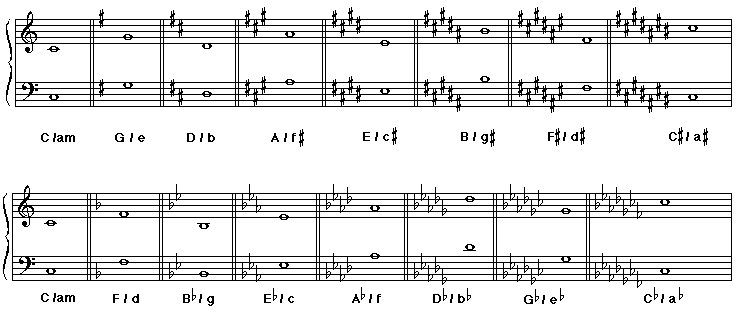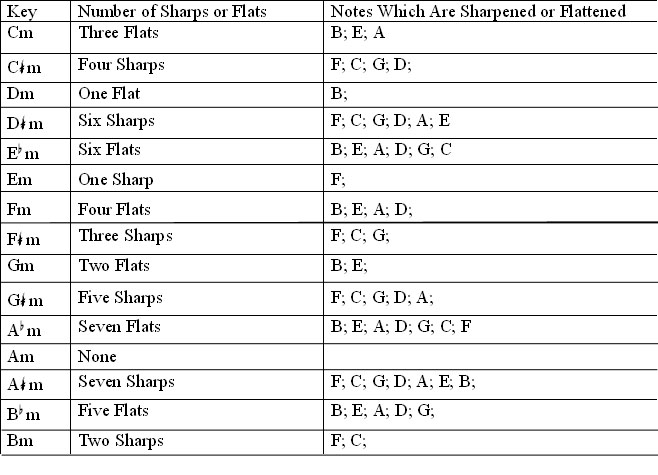
From middle C, we’ll add a note an interval of a major 3rd above. We’ll build a major chord off the root of middle C to get started. Every chord is built off of a starting pitch or root.
#All music keys in order how to
To help you understand how chords work, we’ll start with showing you how to build major chords. Chords usually provide the basic foundation of a piece of music, and the way chords sound and move tend to influence the character of nearly every type of music. A chord is two or more notes that are played at the same time. Now that we’ve covered intervals, we can talk about what chords are and how to build them. When you start to listen to music critically, you’ll begin to pick out intervals once you learn what they sound like. All you need to know for now is that relationships between notes are called intervals, and that these intervals have special names. Don’t worry if you don’t know what these interval names mean yet. Other famous intervals include the minor 2nd found in the Jaws theme, the Tritone found in the theme from The Simpsons, and the Perfect 4th found in the Wedding March. By far, the most famous Perfect 5th in modern music is the one found in the first two notes of the theme from the Star Wars films. We’ll explain how keys and scales work later on in this article.

The “5” in the Perfect 5th interval comes from the fact that G is the fifth note in the key of C major. For example, the distance between C and G on a piano is called a Perfect 5th. The distance or relationship between notes is called an interval. The physics behind notes can explain the tension and release that we hear in music. For example, on a keyboard the A above the middle C is known as “A440” because the pitch vibrates 440 times in a second (the middle C is the C note found in the middle of an 88-key keyboard). Music theory gives each pitch its own name by measuring how many times it vibrates in a second. In basic music theory, the furthest we can zoom in is down to the individual pitches we hear in music and in the world around us. To fully understand something, you usually need to zoom in as far as you can to check things out on the smallest scale possible before you can fully comprehend the bigger picture of how it works. If you don’t have access to one, I recommend printing out a picture of the keys on the keyboard to help serve as a visual of how to understand basic music theory concepts. If you have a piano or keyboard around, use it as a guide to help you understand music theory. If you can memorize a few simple music theory rules and ideas, you’ll be able to gain an incredibly powerful new perspective on the art form of music, and you’ll be able to apply what you learn to whatever role you play in music. Well, don’t despair! I’m here to tell you that mastering the ins and outs of basic music theory is actually not that hard. If you’re a musician who learns by way of listening to how a piece of music sounds and feels, the task of learning how to understand basic music theory concepts might feel daunting or downright impossible. Yes, there are exceptions, but most serious musicians in it for the long haul take the time and energy to learn basic music theory because it gives context and agency to their craft. Music theory is a device purely meant to explain and describe the rules that govern music and the way it operates. Before I learned about it in school, basic music theory just seemed like a bunch of meaningless and detached rules and ideas menacingly floating around in the ether.
#All music keys in order for free
In addition to the online chart on this page, I’ve created a beautiful printable version of the Key Signature Chart, available for free download! Simply click this link to view the printable chart, or right-click and select “Save” to save it to your computer.I have to confess something: Maybe it’s just nostalgia getting to me, but after a decade since graduating from college with a degree in music composition the words “music theory” still manage to inspire a considerable amount of anxiety in me sometimes. Note that the sharps follow the Circle of Fifths clockwise, while the flats follow it counterclockwise. The right column shows the accidentals (sharps or flats): Notice how each sharp is always a fifth above the last (G-sharp, D-sharp, A-sharp…) and each flat is always a fifth below the previous one (B-flat, E-flat, A-flat…).

As you study it you’ll quickly learn its patterns and discover that it’s not nearly as difficult as it seems at first glance. It’s essential for all musicians to memorize the key signatures. It’s written with increasing sharps and flats.

This Key Signature Chart is designed to help you learn all the key signatures easily.


 0 kommentar(er)
0 kommentar(er)
